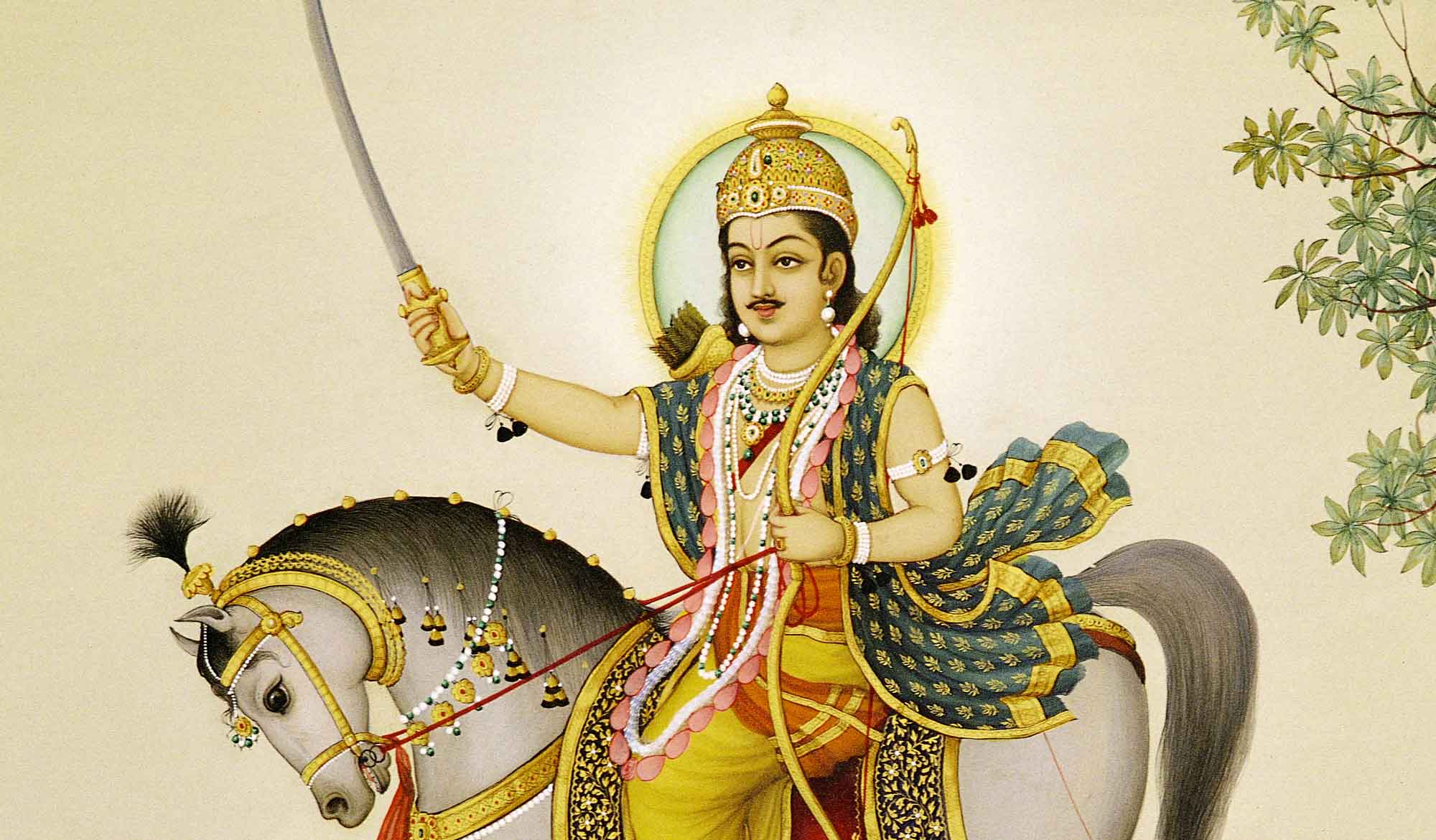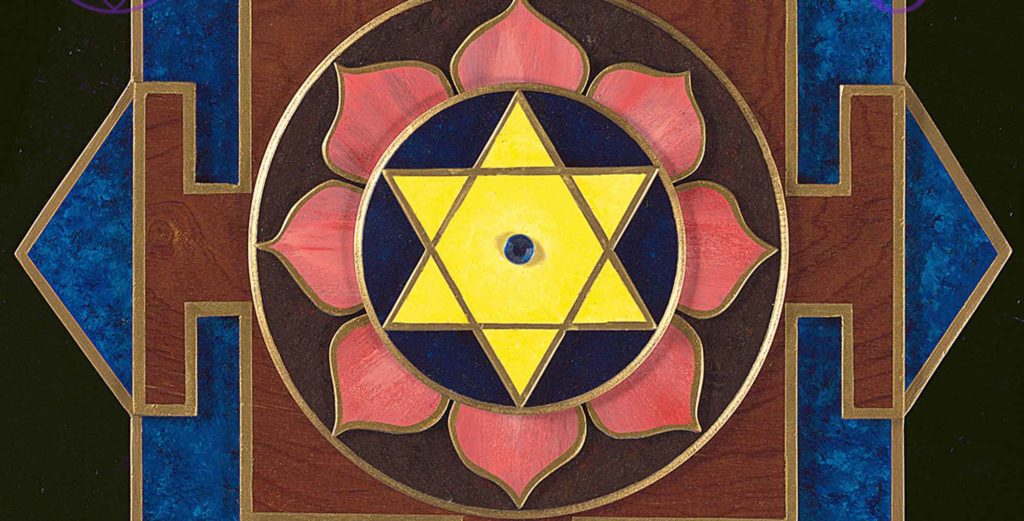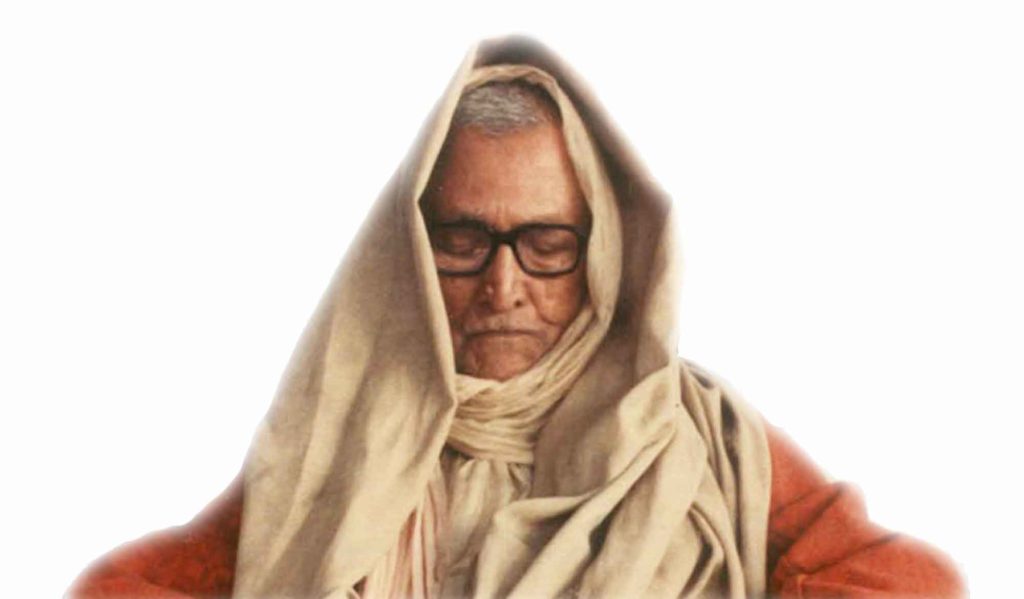Overview
“Dawn of the Age of Love” was written in 2009 by Śrīla Narasiṅgha Mahārāja in response to the erroneous idea that Kalki-avatāra does not appear at the end of this Kali-yuga. Quoting previous ācāryas, he shows that this is not the case.
Opinions are like… well, noses – everyone has one. But the secret is that some opinions are more valued than others. In this regard, at present, numerous opinions abound about there being or not being an advent of Kalki-avatāra at the end of Kali-yuga.
Although Śrīmad Bhāgavatam has mentioned the appearance of Kalki-avatāra at the end of this Kali-yuga, some preachers are of the opinion that due to ‘the dawn of the age of love’ there will be no appearance of Kalki-avatāra at the end of this Kali-yuga.
Is this a new idea that some preachers have advocated based on their realizations, or has this idea been around for some time, and if so, where did it come from?
Firstly, we can say with absolute certainty that the idea of ‘no Kalki-avatāra’ at the end of Kali-yuga did not come from Bhaktivinoda Ṭhākura, Sarasvatī Ṭhākura, Śrīla B.R.Śrīdhara Mahārāja, Śrīla B.P. Purī Mahārāja, Śrīla B.P.Keśava Mahārāja, Śrīla Bhaktivedanta Swami Prabhupāda or any previous ācārya in the Caitanya Sārasvata paramparā. So where did the ‘no Kalki-avatāra’ idea come from and how has it worked its way into the contemporary paramparā of Śrīla Bhaktisiddhānta Sarasvatī Ṭhākura and his followers?
The answer to our question is found in an open secret, or should we say book ‘The Dawn of the Age of Love‘ written by Kānupriya Gosvāmī, first published in Bengali in 1929 in the Sonar Gauranga monthly magazine. There Kānupriya has written:
“In this Kali-yuga the Lord has no pastimes of taking up weapons. At the climatic point of an ordinary Kali-yuga, when the whole world is filled with sins and offences, then the Lord appears to destroy the mlecchas in His Kalki incarnation. Because the Supreme Lord has Himself taken the responsibility for spreading the yuga-dharma, there is no need for a separate partial or empowered incarnation for any reason.”
The above quote is the first reference in any book that we could find that alludes to the concept of ‘no Kalki-avatāra’ at the end of Kali-yuga. Since the Gosvāmī makes no reference for his statement, we are thereby left to conclude that this was his own opinion.
All seems well enough if you have no other point of reference to Kānupriya Gosvāmī — in which case one may easily accept the ‘no Kalki-avatāra’ idea. But upon discovering the background/history of Kānupriya Gosvāmī, one easily rejects his statement as mere speculation.
Kānupriya Gosvāmī was a well-known Bengali panḍīta in the early 20th century, who resided in Bhajan-ghāṭa in Prachin Māyāpura, Navadvīpa, and who published several books on Caitanya Vaiṣṇavism (Jīvera Svarūpa O Svadharma, Śrī Nāma-cintāmaṇi, Bhakti-rahasya Kaṇikā, Mahat-saṅga Prasaṅga, Śrī Bhāgavatāmṛta Kaṇa and The Dawn of the Age of Love). He was a brahmacārī/ācārya and by birth his paramparā belonged to that of the Kānu Ṭhākura branch of the Nityānanda Vaṁśa.
From the 1920s until his death Kānupriya Gosvāmī was an outspoken opponent of the Gauḍīya Maṭha.
In the Nadīyā Prakāśa and Gauḍīya publications of that same era, numerous articles were written by Bhaktisiddhānta and his followers to defeat Kānupriya’s accusations against Gauḍīya Maṭha and to proclaim to the Vaiṣṇava world that Kānupriya Gosvāmī’s conceptions were tinged with sahajiyaism and mental speculation. The mental speculation, amongst other things, was that there will be no Kalki-avatāra at the end of Kali-yuga.
It should be obvious to any discerning devotee that when Bhāgavatam is being contradicted and no reference to a previous ācārya is given, such writings, ideas and conceptions are fit to be rejected. But in Kali-yuga, the general class of devotees often don’t easily take notice of the obvious.
One important ācārya to reference in this regard would be Śrīla Rūpa Gosvāmī, the head of our sampradāya, who was hand-picked for that position by Śrī Caitanya. In light of these credentials, Rūpa Gosvāmī certainly knows a thing or two about the avatars. Regarding the Kalki-avatāra, Rūpa Gosvāmī has written in Laghu-Bhāgavatāmṛtam as follows:
āveśatvaṁ kalkino’pi viṣṇu-dharme vilokyate:
pratyakṣa-rūpa dhṛg devo dṛṣyate na kalau hariḥ
kṛtādiṣv iva tenaiva tri-yugaḥ paripaṣṭhyate
kaler ante ca samprāpte kalkinam brahma-vādinam
anupraviṣya kurute vāsudevo jagat-sthitim
pūrvotpanneṣu bhūteṣu tesu tesu kalau prabhuḥ
kṛtvā praveśaṁ kurute yad abhipretam ātmanaḥ
“In the Viṣṇu-dharma Purāṇa it is seen that Kalki is an aveśa-avatāra: In Kali-yuga Lord Hari is not seen in a directly visible incarnation as He is seen in the Satya and other yugas. Therefore, it is stated that He appears in three yugas (tri-yuga). At the end of Kali-yuga, Lord Vasudeva enters the learned scholar Kalki and corrects the situation in the material world. Then entering many saintly persons who had taken birth before, the Lord fulfils His plan in Kali-yuga.” (Laghu-Bhāgavatāmṛta 4.41-43)
How does an idea that contradicts the Bhāgavatam and the sampradāya-ācārya, that has no bona-fide reference anywhere and is propagated by a known sahajiyā and opponent of Bhaktisiddhānta Sarasvatī Ṭhākura gain entrance into our sampradāya?
How did this bogus idea of ‘no Kalki-avatāra’ get new life and make its way into the field of contemporary Vaiṣṇavism among the grand disciples of Śrīla Bhaktisiddhānta? In short — deviation and a lack of attention to details.
The trail leads back to two infamous Gauḍīya Maṭha personalities, Ananta Vāsudeva and Sundarānanda Vidyāvinoda. Both these personalities were defectors from Gauḍīya Maṭha in 1947 (approximately ten years after the departure of Sarasvatī Ṭhākura). After leaving Gauḍīya Maṭha, Ananta Vāsudeva went to Vṛndāvana where he sought out siddha-praṇālī dīkṣā and Sundarānanda Vidyāvinoda returned to his family guru in Navadvīpa.
Kānupriya Gosvāmī was formerly the family guru of Sundarānanda Vidyāvinoda with whom he reconnected. Sundarānanda also introduced Fakir Mohan, a third Gauḍīya Maṭha defector, to Kānupriya Gosvāmī from whom Fakir Mohan took dikṣā. Fakir Mohan had been a disciple of Ananta Vāsudeva as well as a junior editor for Ananta Vāsudeva under Sundarānanda.
Bhaktivedānta Swami Prabhupāda has written the following condemnation of the infamous Vāsudeva.
“One of your closest disciples, the jackal Vāsudeva (śṛgala-vāsudeva), has rejected your instructions (tomāra upadeśa tyāji). His regrettable preference for infectious poison has resulted in an epidemic of worshipping and serving sahajiyās (sahajiyā-sevā). Where are your instructions still being followed? As it is said: ‘punār mūṣika bhava’ – everyone has ‘again become a mouse’ (‘punāra-mūṣika’ saba haila apāni). Today the lion’s food has been stolen by the jackal and everyone is reduced to tears as they are caught in māyā’s clutches.” (Virāha-aṣṭakam, ch 5)
That Kānupriya Gosvāmī may be at the root of numerous sahajiyā concepts that have crept theri way into contemporary Vaiṣṇavism is confirmed from the following statement of an ISKCON ācārya in 1994.
“Yes. Kānupriya Gosvāmī has said that after 500 years of Mahāprabhu’s appearance we observed a festival, the 500th year, the fifth centennial of Mahāprabhu’s appearance. He has said it will spread more, particularly in the west. That has happened now. In Russia, you find it is banned, but there are so many Russians and they are coming to India in great numbers. That is the symptom. In the west it spreads more than in India. That is because they cannot get peace, going from the top of material enjoyment, you see, the highest level, no peace. So now it is catching up. It is spreading there. In India it is not spreading so much. India is like the wet well (the grass is very green around it) and the west is like a dry well (the grass is very dry around it). The west is like a dry well; the fire catches easily; but India is a wet well. Kānupriya Gosvāmī said this. It is because in India there are so many organizations and they all say, “O, I know”, “We know, we know”. So it is not spreading so much. But in the west it is spreading. After the 500th anniversary of Mahāprabhu it will spread. He has said that, and it is taking place. He said that from 1986, (Mahāprabhu’s 500th anniversary, 1486 to 1986, 500 years) Mahāprabhu’s movement will spread. Devotees will come up, then Kali will become weaker, so Kali became weaker from that day in 1986. Then he said, “Still Kali will stay in the movement; he has some strength and it will last for 10 years.” That will be from 1986 to 1996. For ten years it will remain but it will become weaker and weaker. But in 1996, no more! Prema, prema – love will come. “The prema-yuga will come”, he said. Kānupriya Gosvāmī also said this. He was from Navadvīpa and he comes in the line of Śrī Caitanya Mahāprabhu.
“Then there is Fakir Mohan Das, a local research scholar, he is a Vaiṣṇava. He is a professor at Utkal University. He has a Ph.D. in Sanskrit and is presenting a thesis on Mahāprabhu. In this thesis he has written all that Kānupriya Gosvāmī has predicted. So aparādhās, nāma-aparādhās are still there now, but after 1996 there will be no nāma-aparādhā. Then the prema-yuga will come. Kānupriya Gosvāmī has predicted this.” (Recorded in Bhubaneshwar, India 1994)
It seems that the above prediction, despite its boasting of Kānupriya Gosvāmī and Fakir Mohan as reputable Vaiṣṇavas, has failed to come true. There is still plenty of nāma-aparādhā to be found and misconceptions have now become mainstream conceptions among many western Vaiṣṇavas and particularly in ISKCON.
Another ISKCON member further confirms the influence of Kānupriya Gosvāmī upon ISKCON with the following statement.
“From what I have heard from tapes and from the mouths of Fakir Mohan Prabhu and our Guru Mahārāja, they did not meet so many times. Prabhu (Fakir Mohan) would sometimes bring books of his dīkṣā-guru’s writings (Śrīla Kānupriya Gosvāmī) for our Guru Mahārāja. Mahārāja was very appreciative and they spoke a number of times about the prema-yuga and about the esoteric significance of Jagannātha Purī Dhāma. Our Guru Mahārāja requested him to be in charge of a Vaiṣṇava college that he wanted to start in Orissa.” (Bhubaneshwar, India 2005)
(*Note: Fakir Mohan continues to the present day to act in the capacity of giving śikṣā to the residents of ISKCON, Bhubaneshwar)
But the ISKCON section of Vaiṣṇavas are not alone, as certain Indian born, second generation disciples of Bhaktisiddhānta (posing as Gauḍīya Maṭha) are also championing the misconceptions of Kānupriya Gosvāmī by preaching that there will be no Kalki-avatāra in this Kali-yuga. One such ācārya is quoted as saying:
“Śrīla Mahārāja mentioned a few times that in this age of Kali, Kalki-avatāra doesn’t come… Not in this Kali-yuga. He won’t come. But if he comes; no harm. He will be raising his arms and chanting, “Haribol, Haribol” in Mahāprabhu’s saṅkīrtana movement.”
The argument is that Kalki-avatāra is a līlā-avatāra and that there are no līlā-avatāras in Kali-yuga. To support this premise Śrīla Bhaktivedanta Swami Prabhupāda’s purport to Caitanya-caritāmṛta, Madhya-līlā 6.99 is quoted. There Kalki-avatāra is mentioned as the last of the twenty-five līlā–avatāras. The rationale has become — Kalki-avatāra equals līlā-avatāra, equals no līlā-avatāra in Kali-yuga, equals no Kalki-avatāra in this Kali-yuga! However, this simple reading of the purport and convenient conclusion is certainly something that only a thirty-two-ounce brain (or less) could come up with.
What is missed in the reading is that Buddha, who also appeared in Kali-yuga is mentioned as a līlā–avatāra (as were Parasurāma, Nārada, Pṛthu, the Four Kumāras and Vyāsa in other yugas) yet the deeper study of Bhāgavatam and Vaiṣṇava literature in general confirms that Buddha as well as Kalki-avatāra and the others mentioned here are actually aveśa-avatāras. In this regard we have already quoted Rūpa Gosvāmī above.
Our conclusion is supported by previous ācāryas, such as Śrīla Bhaktivedanta Svami Prabhupāda and our śikṣā-guru Śrīla B.R. Śrīdhara Deva Gosvāmī, that Kalki-avatāra will appear at the end of this Kali-yuga — if one doesn’t want to be here when that happens then one should give up all connection with Kānupriya Gosvāmī and those influenced by his misconceptions.
Related Articles and Books
- Śrī Dāmodara Kathā – The History of Rādhā Dāmodara Temple (Book)
- Kṛṣṇa-tattva (The Fundamental Reality of Śrī Kṛṣṇa) by Śrīla Bhaktisiddhānta Sarasvatī Ṭhākura
- The Ontological Position of Śrī Śrī Rādhā-Govinda by Śrīla Bhakti Rakṣaka Śrīdhara Deva Gosvāmī
- Śrī Govardhana Pūjā by Śrīla Bhakti Rakṣaka Śrīdhara Deva Gosvāmī
- Śrī Narasiṁha Caturdaśī by Śrīla Bhakti Rakṣaka Śrīdhara Deva Gosvāmī
- Śrī Śrī Rādhā Kṛṣṇa – The Fountainhead of All Tattvas by Śrīla Bhakti Pramoda Purī Gosvāmī
- Kṛṣṇa – The Supreme Vedāntist by Śrīla A.C. Bhaktivedānta Swami Prabhupāda
- Dāsa Gosvāmī and the Unique Position of Govardhana by Śrīla Bhakti Gaurava Narasiṅgha Mahārāja
- The Worship of Govardhana by Śrīla Bhakti Gaurava Narasiṅgha Mahārāja
- Śrī Kṛṣṇa Janmāṣṭamī by Śrīla Bhakti Gaurava Narasiṅgha Mahārāja
- Questions and Answers on Baladeva Tattva by Śrīla Bhakti Gaurava Narasiṅgha Mahārāja
- The Worship of Lord Narasiṁha by Śrīla Bhakti Gaurava Narasiṅgha Mahārāja
- The Dawn of the Age of Love? by Śrīla Bhakti Gaurava Narasiṅgha Mahārāja
Further Reading
- Śrī Kṛṣṇa Saṁhitā by Srila Bhaktivinoda Thakura (Book)
- Impersonal Spirituality and Transcendental Spirituality by Śrīla Bhaktivinoda Ṭhākura
- Servitorship to Kṛṣṇa by Śrīla Bhaktivinoda Ṭhākura
- The Glories of Puruṣottama Māsa by Śrīla Bhaktivinoda Ṭhākura
- Identifying the Supreme Object by Śrīla Bhaktivinoda Ṭhākura
Prema Dhāma Deva Stotram with the Narasiṅgha Sevaka Commentary – Verses 61-65
In verses 61 to 65 of 'Prema Dhāma Deva Stotram', Śrīla Śrīdhara Mahārāja narrates the pastime of Śrī Caitanya at Caṭaka Parvata In Purī and explains how the scriptures produced by Brahmā and Śiva are ultimately searching for the personality of Mahāprabhu who is merciful too all jīvas, no matter what their social position.
Prabhupāda Śrīla Sarasvatī Ṭhākura’s Visit to Ayodhyā
With the forthcoming observance of Śrī Rāma Navamī, we present 'Prabhupāda Śrīla Sarasvatī Ṭhākura’s Visit to Ayodhyā' written by Śrīla Bhaktisiddhānta Sarasvatī Ṭhākura Prabhupāda from The Gaudīyā magazine, Vol 3. Issue 21/ In December 1924, after visiting Benares and Prāyāga, Sarasvatī Ṭhākura visited the birth-site of Śrī Rāmācandra in Ayodhyā.
Śaraṇāgati – The Only Path to Auspiciousness
In this article, 'Śaraṇāgati - The Only Path to Auspiciousness', Dhīra Lalitā Dāsī analyses the process of śaraṇāgati (surrender) beginning with śraddhā (faith). She also discusses the role of śāstra and the Vaiṣṇava in connection with surrender.
Ātma Samīkṣā – The Value of Introspection
In this article, "Ātma Samīkṣā – The Value of Introspection" Kalki Dāsa highlights the importance of introspection in the life of a devotee and especially in relation to the worldly environment that surrounds us. He also explains how transcendental sound influences our capacity to introspect.
Prema Dhāma Deva Stotram with the Narasiṅgha Sevaka Commentary – Verses 61-65
In verses 61 to 65 of 'Prema Dhāma Deva Stotram', Śrīla Śrīdhara Mahārāja narrates the pastime of Śrī Caitanya at Caṭaka Parvata In Purī and explains how the scriptures produced by Brahmā and Śiva are ultimately searching for the personality of Mahāprabhu who is merciful too all jīvas, no matter what their social position.
Prabhupāda Śrīla Sarasvatī Ṭhākura’s Visit to Ayodhyā
With the forthcoming observance of Śrī Rāma Navamī, we present 'Prabhupāda Śrīla Sarasvatī Ṭhākura’s Visit to Ayodhyā' written by Śrīla Bhaktisiddhānta Sarasvatī Ṭhākura Prabhupāda from The Gaudīyā magazine, Vol 3. Issue 21/ In December 1924, after visiting Benares and Prāyāga, Sarasvatī Ṭhākura visited the birth-site of Śrī Rāmācandra in Ayodhyā.
Śaraṇāgati – The Only Path to Auspiciousness
In this article, 'Śaraṇāgati - The Only Path to Auspiciousness', Dhīra Lalitā Dāsī analyses the process of śaraṇāgati (surrender) beginning with śraddhā (faith). She also discusses the role of śāstra and the Vaiṣṇava in connection with surrender.
Ātma Samīkṣā – The Value of Introspection
In this article, "Ātma Samīkṣā – The Value of Introspection" Kalki Dāsa highlights the importance of introspection in the life of a devotee and especially in relation to the worldly environment that surrounds us. He also explains how transcendental sound influences our capacity to introspect.








